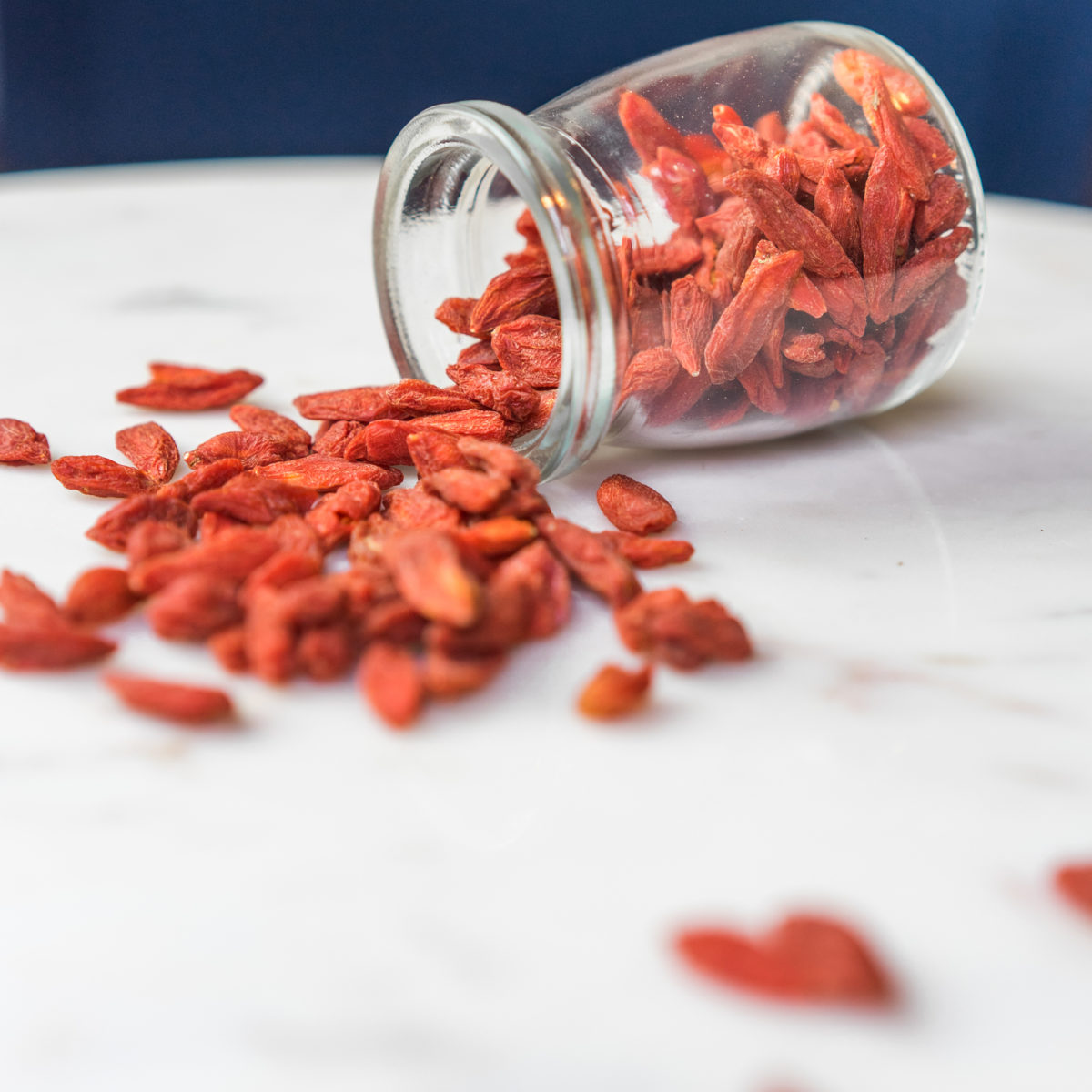
COMMON NAME (Chinese Name)
Goji Berry (Gǒu Qǐ Zi)
BOTANICAL NAME
Lycium Barbarum
USES
Goji berries are rich in flavonoids and carotenoids which act as antioxidants and stabilize small capillaries. They can be used to treat or prevent varicose/spider veins, peripheral neuropathies, cold feet, and intermittent claudication (it increases circulation to the legs and feet.) They are also useful for anemia due to dysfunctional uterine bleeding.
Goji, or Lycium, berries are categorized in Chinese medicine as an herb that tonifies the blood, which accounts for their use in anemia. They are classified as sweet and warm and primarily affect the Liver, Lung and Kidney channels. Goji berries are considered antioxidant, chemoprotective, liver protective, raise blood sugar, mildly lower blood pressure, are an immune tonic, and a nourishing food. Not all of these uses are adequately studied. The plant is high in flavonoids, Zeaxanthine and Cryptoxanthine, Polysaccharides, Linoleic Acid, and Vitamins B1, B2 and C.
Go qi zi is believed to nourish the Chinese Liver to improve the eyesight: its flavonoids stabilize the integrity of the small capillaries and can be used for red, dry, tired eyes, diabetic retinopathy, poor night vision, detached retina, wet macular degeneration, spots in the eyes, excessive tearing, cloudy vision, and it helps prevents glaucoma & cataracts.
Because it is a potent antioxidant, various preparations of goji berries (and their derivatives including goji berry juice, supplements, and decoctions) show significant promise for use in anti-aging skincare products, especially for treating sun-damaged skin. What’s more, drinking goji berry juice can lead to improved overall feelings of well-being, better cognitive performance*, and more regular, comfortable gastric function. Additionally, drinking goji berry juice daily can improve sleep quality, increase energy levels, and even boost athletic performance (though these effects are not immediately apparent after one dose).
As a dietary supplement, goji berry juice may do more than merely regulate gut flora to ease digestion; it may also help balance natural insulin levels while also lowering blood sugar and cholesterol, especially in people who are overweight or who follow a high-fat diet. Contrary to many claims, drinking goji berry juice hasn’t been confirmed to increase metabolism or help burn stubborn abdominal fat, slimming users’ waistlines.
* Notably, recent research suggests that Calabrian goji berry fruits, supplements, juice, and decoctions may have even better cognitive health benefits than similar Chinese goji berry derivatives.
PREPARATION & ADMINISTRATION
Eating the whole fruits and/or drinking the juice are the most popular ways to incorporate goji berry into your diet, with many recipes available online for adding whole goji berries to everyday meals. Nevertheless, goji berries are also available for purchase dried, powdered, and decocted (for use in teas) as well as in capsule form.
PRECAUTIONS
Though the chances of having an allergic reaction are rare, people who have a history of allergic reactions to food, especially nightshades and foods containing LTP (like stone fruits and tomatoes), are at a greater-than-average risk of having allergic reactions to goji berry derivatives. Additionally, due to the risk of interaction, people taking warfarin and similar blood-thinning medications should not ingest goji berry supplements, fruits, or juices except under medical supervision.
You should consult with a certified herbalist, physician or other qualified healthcare professional before taking goji berry.
REFERENCES
Amagase, Harunobu, and Dwight M. Nance. “A Randomized, Double-Blind, Placebo-Controlled, Clinical Study of the General Effects of a Standardized Lycium Barbarum (Goji) Juice, GoChi™.” The Journal of Alternative and Complementary Medicine, vol. 14, no. 4, 2008, pp. 403–412., doi:10.1089/acm.2008.0004.
Amagase, Harunobu, and Dwight M Nance. “Lycium BarbarumIncreases Caloric Expenditure and Decreases Waist Circumference in Healthy Overweight Men and Women: Pilot Study.” Journal of the American College of Nutrition, vol. 30, no. 5, 2011, pp. 304–309., doi:10.1080/07315724.2011.10719973.
Chen, John, Chen, T & Cramton, L. Art of Medicine Press, Inc. City of Industry, CA USA. 2003. 1327 pp ISBN: 0-9740635-0-9 , http://aompress.com/herbology
Cheng, J., Zhou, Z. W., Sheng, H. P., He, L. J., Fan, X. W., He, Z. X., Sun, T., Zhang, X., Zhao, R. J., Gu, L., Cao, C., & Zhou, S. F. (2014). An evidence-based update on the pharmacological activities and possible molecular targets of Lycium barbarum polysaccharides. Drug design, development and therapy, 9, 33–78. https://doi.org/10.2147/DDDT.S72892
Cheng HE. Modified Bazhen Tang plus artificial menstrual cycle in the treatment of 84 cases of anovulatory dysfunctional uterine bleeding. Anhui Clinl J TCM. 1999;11:238–9. [Google Scholar]
Cheng, J., Zhou, Z. W., Sheng, H. P., He, L. J., Fan, X. W., He, Z. X., … & Zhou S. F. (2015). An evidence-based update on the pharmacological activities and possible molecular targets of Lycium barbarum polysaccharides [Abstract]. Drug Design, Development and Therapy, 9, 33–78 https://www.ncbi.nlm.nih.gov/pubmed/25552899
Driessche, José J. Van Den, et al. “A Single Dose of Goji Berries Does Not Affect Postprandial Energy Expenditure and Substrate Oxidation in Healthy, Overweight Men.” Journal of Nutrition and Metabolism, vol. 2019, 2019, pp. 1–6., doi:10.1155/2019/4057143.
Gao, Yanjie, et al. “Lycium Barbarum: A Traditional Chinese Herb and A Promising Anti-Aging Agent.” Aging and Disease, vol. 8, no. 6, 2017, p. 778., doi:10.14336/ad.2017.0725.
Kang, Yifei, et al. “Goji Berry Modulates Gut Microbiota and Alleviates Colitis in IL-10-Deficient Mice.” Molecular Nutrition & Food Research, vol. 62, no. 22, July 2018, p. 1800535., doi:10.1002/mnfr.201800535.
Kulczyński, Bartosz, and Anna Gramza-Michałowska. “Goji Berry (Lycium Barbarum): Composition and Health Effects – a Review.” Polish Journal of Food and Nutrition Sciences, vol. 66, no. 2, 2016, pp. 67–75., doi:10.1515/pjfns-2015-0040.
Lam, A Y, et al. “Possible Interaction between Warfarin and Lycium Barbarum L.” The Annals of Pharmacotherapy, U.S. National Library of Medicine, Oct. 2001, https://www.ncbi.nlm.nih.gov/pubmed/11675844.
Larramendi, C H, et al. “Goji Berries (Lycium Barbarum): Risk of Allergic Reactions in Individuals with Food Allergy.” Journal of Investigational Allergology & Clinical Immunology, U.S. National Library of Medicine, 2012, https://www.ncbi.nlm.nih.gov/pubmed/23101309.
Medical News Today “10 Scientifically proven benefits of goji berries.” https://www.medicalnewstoday.com/articles/322693#seven-scientifically-proven-benefits
